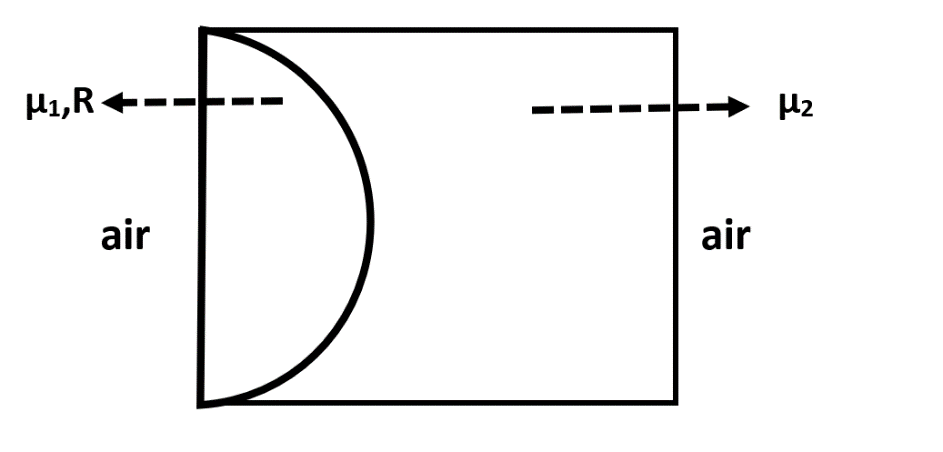
Answer
402.3k+ views
Hint: The combination of lenses in the given figure are plano convex lens and plano concave lens and these lenses have a common surface of contact. Also on the other side of the convex lens we have air and on the other side of the concave lens, we have air. Thus we shall find the focal length of both lenses separately and use the formula of finding the combined focal length of more than one lens set up.
Complete answer:
Since these are lenses with two different focal lengths at each side, therefore we will use Lens maker’s formula to write their respective focal lengths. Mathematically, the lens maker’s formula can be written as:
$\Rightarrow \dfrac{1}{f}=(\mu -1)\left[ \dfrac{1}{{{R}_{1}}}-\dfrac{1}{{{R}_{2}}} \right]$
Where,
$f$ is the focal length.
$\mu $ is the refractive index of glass used. And,
${{R}_{1}}$ and ${{R}_{2}}$ are the radius of curvature of two sides of the lens.
Now, let the focal length of plano convex lens be given by ${{f}_{1}}$ and let the focal length of plano concave lens be given by ${{f}_{2}}$ . Then, we can calculate them as follows:
$\begin{align}
& \Rightarrow \dfrac{1}{{{f}_{1}}}=({{\mu }_{1}}-1)\left[ \dfrac{1}{\infty }-\left( \dfrac{1}{-R} \right) \right] \\
& \Rightarrow \dfrac{1}{{{f}_{1}}}=\dfrac{({{\mu }_{1}}-1)}{R} \\
\end{align}$
And for second lens, we have:
$\begin{align}
& \Rightarrow \dfrac{1}{{{f}_{2}}}=({{\mu }_{2}}-1)\left[ \left( \dfrac{1}{-R} \right)-\dfrac{1}{\infty } \right] \\
& \Rightarrow \dfrac{1}{{{f}_{2}}}=\dfrac{({{\mu }_{2}}-1)}{-R} \\
\end{align}$
Now, for a combination of lens having different focal lengths, the resultant focal length (say ${{f}_{R}}$) can be written as:
$\Rightarrow \dfrac{1}{{{f}_{R}}}=\dfrac{1}{{{f}_{1}}}+\dfrac{1}{{{f}_{2}}}$
Putting the values of all the respective terms in the above equation, we get:
$\begin{align}
& \Rightarrow \dfrac{1}{{{f}_{R}}}=\dfrac{({{\mu }_{1}}-1)}{R}+\dfrac{({{\mu }_{2}}-1)}{-R} \\
& \Rightarrow \dfrac{1}{{{f}_{R}}}=\dfrac{{{\mu }_{1}}-1-{{\mu }_{2}}+1}{R} \\
& \Rightarrow \dfrac{1}{{{f}_{R}}}=\dfrac{{{\mu }_{1}}-{{\mu }_{2}}}{R} \\
& \therefore {{f}_{R}}=\dfrac{R}{{{\mu }_{1}}-{{\mu }_{2}}} \\
\end{align}$
Hence, the equivalent focal length of the given lens combination is equal to $\dfrac{R}{{{\mu }_{1}}-{{\mu }_{2}}}$.
Hence, option (A) is the correct option.
Note:
There are many different formulas and theories in the chapter of optics. So, one should know which formula is to be applied when. This lens used in this problem is attached perpendicularly. If they were attached side by side then the resultant lens would be a bifocal lens which is generally used by old people.
Complete answer:
Since these are lenses with two different focal lengths at each side, therefore we will use Lens maker’s formula to write their respective focal lengths. Mathematically, the lens maker’s formula can be written as:
$\Rightarrow \dfrac{1}{f}=(\mu -1)\left[ \dfrac{1}{{{R}_{1}}}-\dfrac{1}{{{R}_{2}}} \right]$
Where,
$f$ is the focal length.
$\mu $ is the refractive index of glass used. And,
${{R}_{1}}$ and ${{R}_{2}}$ are the radius of curvature of two sides of the lens.
Now, let the focal length of plano convex lens be given by ${{f}_{1}}$ and let the focal length of plano concave lens be given by ${{f}_{2}}$ . Then, we can calculate them as follows:
$\begin{align}
& \Rightarrow \dfrac{1}{{{f}_{1}}}=({{\mu }_{1}}-1)\left[ \dfrac{1}{\infty }-\left( \dfrac{1}{-R} \right) \right] \\
& \Rightarrow \dfrac{1}{{{f}_{1}}}=\dfrac{({{\mu }_{1}}-1)}{R} \\
\end{align}$
And for second lens, we have:
$\begin{align}
& \Rightarrow \dfrac{1}{{{f}_{2}}}=({{\mu }_{2}}-1)\left[ \left( \dfrac{1}{-R} \right)-\dfrac{1}{\infty } \right] \\
& \Rightarrow \dfrac{1}{{{f}_{2}}}=\dfrac{({{\mu }_{2}}-1)}{-R} \\
\end{align}$
Now, for a combination of lens having different focal lengths, the resultant focal length (say ${{f}_{R}}$) can be written as:
$\Rightarrow \dfrac{1}{{{f}_{R}}}=\dfrac{1}{{{f}_{1}}}+\dfrac{1}{{{f}_{2}}}$
Putting the values of all the respective terms in the above equation, we get:
$\begin{align}
& \Rightarrow \dfrac{1}{{{f}_{R}}}=\dfrac{({{\mu }_{1}}-1)}{R}+\dfrac{({{\mu }_{2}}-1)}{-R} \\
& \Rightarrow \dfrac{1}{{{f}_{R}}}=\dfrac{{{\mu }_{1}}-1-{{\mu }_{2}}+1}{R} \\
& \Rightarrow \dfrac{1}{{{f}_{R}}}=\dfrac{{{\mu }_{1}}-{{\mu }_{2}}}{R} \\
& \therefore {{f}_{R}}=\dfrac{R}{{{\mu }_{1}}-{{\mu }_{2}}} \\
\end{align}$
Hence, the equivalent focal length of the given lens combination is equal to $\dfrac{R}{{{\mu }_{1}}-{{\mu }_{2}}}$.
Hence, option (A) is the correct option.
Note:
There are many different formulas and theories in the chapter of optics. So, one should know which formula is to be applied when. This lens used in this problem is attached perpendicularly. If they were attached side by side then the resultant lens would be a bifocal lens which is generally used by old people.
Recently Updated Pages
Who among the following was the religious guru of class 7 social science CBSE

what is the correct chronological order of the following class 10 social science CBSE

Which of the following was not the actual cause for class 10 social science CBSE

Which of the following statements is not correct A class 10 social science CBSE

Which of the following leaders was not present in the class 10 social science CBSE

Garampani Sanctuary is located at A Diphu Assam B Gangtok class 10 social science CBSE

Trending doubts
A rainbow has circular shape because A The earth is class 11 physics CBSE

Fill the blanks with the suitable prepositions 1 The class 9 english CBSE

Which are the Top 10 Largest Countries of the World?

How do you graph the function fx 4x class 9 maths CBSE

The Equation xxx + 2 is Satisfied when x is Equal to Class 10 Maths

Give 10 examples for herbs , shrubs , climbers , creepers

Change the following sentences into negative and interrogative class 10 english CBSE

Difference between Prokaryotic cell and Eukaryotic class 11 biology CBSE

Why is there a time difference of about 5 hours between class 10 social science CBSE





